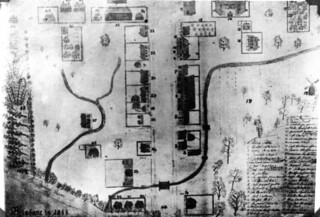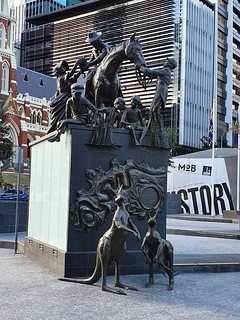In 1827 a treadmill and windmill were built on the hill just above the settlement (now Wickham Terrace). A track from the back of the Convict Barracks was constructed in order to bring up the building supplies. A small log bridge was built over the creek roughly where Albert Street and Adelaide Street meet.
While they were both constructed to grind the maize that was cultivated by the convicts for the Moreton Bay penal settlement, Captain Logan saw the treadmill also as an excellent opportunity for punishment. It was euphemistically called by the convicts, the ‘dancing academy’. The mechanism was operated by 16 convicts with 8 persons waiting. They shuffled along the board every five minutes and had rest of approx 15 minutes at the end of each cycle. In normal conditions they would effectively be on the treadmill for about 5 hours and 20 minutes over a 10 to 11 hour day, which include a 2 or 3 hour lunch break. However punishments could see them working on the mill for 14 hours, most with their leg irons on, sometimes with fewer people and therefore with fewer breaks. This was well above daily maximum set by the British Society for the Improvement of Prison Discipline. No wonder that several convicts died while working the treadmill.
The 9 x 12 meter treadmill was covered by a shed and situated across what is now Wickham Terrace, reaching the other side of the road. It was dismantled soon after the convict settlement was closed.
The buildings were finished in 1828 and the windmill is the oldest surviving building in Brisbane (and Queensland for that matter). The treadmill was linked by a shaft to the milling mechanism on the first floor in the stone mill. A second set of milling stone were used for the windmill. Unfortunately the windmill continually broke down, perhaps because of the use of local timber for the milling mechanism, it simply was not strong enough for the milling process. The mill was also not able to operate at all under calm conditions. In early 1836 the windmill was struck by lightning, causing severe damage, including to the treadmill.
In 1837 an urgent appeal was sent to Sydney for a competent builder to look at the problem. Scotsman Andrew Petrie (see below) was sent from Sydney and became the first Superintendent of Works. His first task was to repair the mechanism of the windmill which had never worked properly.
His conclusion was that the he design was wrong and that the construction of the mill mechanism was very poor and that critical parts were missing altogether. He was unable to fix it beyond being useful. It only remained in operation till 1845. The treadmill had to do most of the milling.
Tom Petrie gives us the name of one of the miller, Martin. He appears in the story of an Aboriginal who stuck up ‘old Martin’ and took a bag of corn meal. He stole from the mill at several occasions and was eventually caught and flogged at the convict barracks. The site was encircled by a timber palisade, to prevent convicts to escape and to stop Aboriginals to steal. But despite this convicts did escape and robberies did take place.
After it lost its milling function, the tower served as one of the stations for the first trigonometrical survey of the Moreton Bay district in 1839. This was done in preparation of opening up the area for free settlers. A one mile square section was laid out within a grid. This grid has its origin at this windmill.
In 1841, the Windmill was also the scene of the public execution of local indigenous men, Mullan and Ningavil. They were hanged from the Windmill for the murder of the government surveyors William Tucker and Granville Stapleton, who had entered sacred Aboriginal land without permission. The choice of the Windmill was deliberate it stood on the edge of the closest and largest Aboriginal camp. The execution was meant to dissuade the Aboriginal population from opposing colonial rule, thus perpetuating the Windmill’s already cruel reputation as a place of torture and colonial punishment.
Windmill Hill was immediately situated behind the township and shortly after the penal settlement was closed George Edmonstone established himself as a butcher in Queen Street. At a time without refrigeration sheep had to be slaughter on a as needed basis. For that purpose he had his sheep grazing on Windmill Hill, close to his business. This is shown on this map from 1844.

In 1849 the government decided to sell the building, the interior had been plundered for timber and the mill was in a deplorable state. This was opposed by a group of residents. However, the building was sold for £30, but fortunately the owner was unable to fulfill the financial obligations, however by that time to top of the building with the sails and the gallery had been demolished. Now more forcefully, the citizens supported by the press, wanted to keep the iconic building at such a prominent position in town in public hands. Another building that was under threat at the same time was the Commissariat, to be replaced by a new customs house. Thankfully this time the indecisiveness of the government worked to the advantage of those who wanted to safe the buildings and both the buildings escaped demolition.
In 1855 it became a public observatory. A signal station was added in 1861 and the building was used as such till 1921. A signalling mast is still standing next to the mill. It became the first home of the Queensland Museum (from 1862-1868). A timekeeping installation (alternating between featuring a time ball and time gun) was constructed to assist in regulating clocks and watches as well as a site for wireless radio and telephony research. In 1924 Thomas Elliott installed equipment in the tower to undertake cutting-edge television research; he and Allen Campbell giving a demonstration from the site in 1934 which constituted Queensland’s first television broadcast.
The current structure is hardly recognisable as a windmill, apart from a lack of sails and the cap, it also missing the encircling gallery. As such it was built as a gallery mill. The fact that it is sometimes referred to as a tower mill, might be because of its missing the gallery. A tower mill doesn’t have a gallery. It most likely needed to gallery to catch the wind from as high as possible and also to stay above surrounding trees. Unfortunately to further disguise the building as the original mill is that its sandstone and brickwork has been covered by a layer of concrete. Research has indicated that this is needed to protect the vulnerable sandstone and brick structure underneath. The bricks most likely came from the kiln near the chain of ponds, at the bottom of the hill.

Andrew Petrie
In 1837 Scotman Andrew Petrie (1798 – 20 February 1872) was appointed Superintendent of Works at Moreton Bay. Together with his wife and 4 sons they became the first free (non military) settlers of the new colony. After the penal settlement was closed Petrie stayed and as a builder and architect was responsible for many of the important early buildings that arose in the new township. They had five more sons and one daughter.
His general duty was the supervision of the better class prisoners (not those in iron gangs). These prisoners were engaged in making such necessities as soap and nails, tools and other materials needed for the building activities. They included mechanics, carpenters and blacksmiths. They worked in the lumberyard and on the various projects around the settlement. He also made inspections of government building in the various settlements around Brisbane. As well to government owned sheep and cattle and he placed a number of beacons on navigational hazards in the Brisbane River. He was the first white man to climb Mount Beerwah, one of the Glass House Mountains seen by James Cook, and he was also the first to bring back samples of the Bunya pine.
He also discovered coal at Tivoli and send a casket of it to Sydney. Later on they dug a tunnel and started to mine at the site.
As mentioned above his first job was to fix the mechanics of the windmill. Interestingly the Petrie family arrived powered by a new technology the very first steamer that reached Brisbane, the ‘Stirling Castle’. The same ship that later with Captain Fraser and his wife Eliza run aground at K’gari what later became known as Fraser Island.
On arrival the family was housed in the Female Factory which was vacated in 1837 until the following year Andrew had built his workshop and house further up Queen Street on what is now the corner with Wharf Street (at that time it was simply in the bush). He built this in line with Convict Barracks as he had the foresight that this would become a major thoroughfare.
When the convict settlement was opened up for free settlers Andrew was offered a new job in Sydney, but he decided to stay in Brisbane, where he became a successful builder. His son John – who continued his business – became the first mayor of Brisbane. His son Tom started a farm in North Pine and we come across his name in this history story at many more occasions. Sadly his son Walter drowned in the Creek where it crossed Queen Street. John’s son also called Walter also drowned in the Creek a few years later. In 1848 Andrew himself suffered from a serious ophthalmic attack, whereby he lost his eye-side.

The tableau above depicts the departure of Andrew Petrie for an inland expedition from the Moreton Bay Settlement in 1842. Petrie`s wife Mary is handing him a drinking bottle as their daughter Isabella watches. Young Tom Petrie plays on the river bank with two of his Aboriginal friends. His experiences were later recorded and became a classic document of Aboriginal tribal life. John Petrie, who went on to become Brisbane`s first Mayor and also a prominent engineer, holds his father`s impatient horse. The event is observed a convict recently freed from his shackles by Petrie.
John was 26 when his father got blind and while Andrew stayed in charge John took over most of the construction works. John’s son Andrew Lang became the third generation continuing his grandfathers business. Among the buildings the Petries built are the GPO, Customs House and Parliament House. They also converted the windmill into an observatory tower. All of these buildings have survived and they are a great legacy of the craftsmanship of the family. The company went bankrupt during the financial crisis of 1894 and was later resurrected but only continued with the monument masonry business. Many of these monument can be seen at Toowong Cemetry.